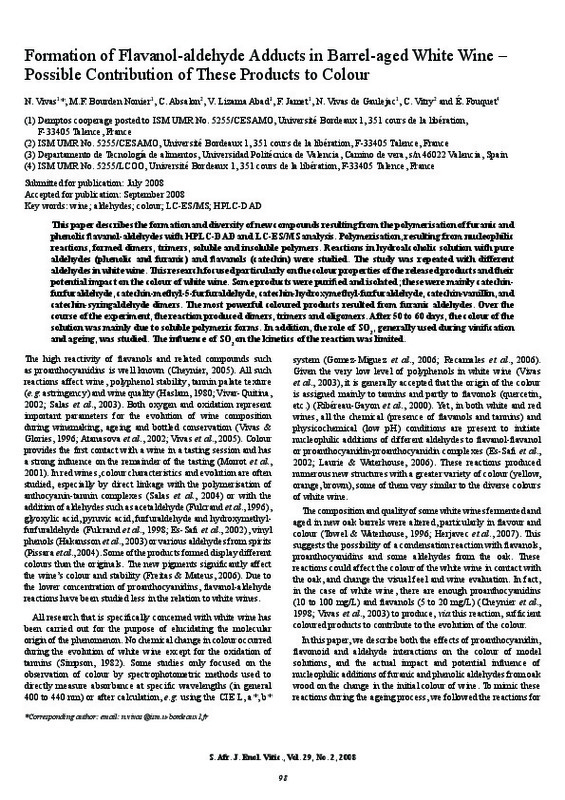JavaScript is disabled for your browser. Some features of this site may not work without it.
Buscar en RiuNet
Listar
Mi cuenta
Estadísticas
Ayuda RiuNet
Admin. UPV
Formation of Flavanol-aldehyde Adducts in Barrel-aged White Wine - Possible Contribution of These Products to Colour
Mostrar el registro sencillo del ítem
Ficheros en el ítem
| dc.contributor.author | Vivas, N.
|
es_ES |
| dc.contributor.author | Nonier, M. F. Bourden
|
es_ES |
| dc.contributor.author | Absalon, C.
|
es_ES |
| dc.contributor.author | Lizama Abad, Victoria
|
es_ES |
| dc.contributor.author | Jamet, F.
|
es_ES |
| dc.contributor.author | de Gaulejac, N. Vivas
|
es_ES |
| dc.contributor.author | Vitry, C.
|
es_ES |
| dc.contributor.author | Fouquet, E.
|
es_ES |
| dc.date.accessioned | 2018-07-05T09:31:33Z | |
| dc.date.available | 2018-07-05T09:31:33Z | |
| dc.date.issued | 2008 | es_ES |
| dc.identifier.issn | 0253-939X | es_ES |
| dc.identifier.uri | http://hdl.handle.net/10251/105310 | |
| dc.description.abstract | [EN] This paper describes the formation and diversity of new compounds resulting from the polymerisation of furanic and phenolic flavanol-aldehydes with HPLC¿DAD and LC¿ES/MS analysis. Polymerisation, resulting from nucleophilic reactions, formed dimers, trimers, soluble and insoluble polymers. Reactions in hydroalcoholic solution with pure aldehydes (phenolic and furanic) and flavanols (catechin) were studied. The study was repeated with different aldehydes in white wine. This research focused particularly on the colour properties of the released products and their potential impact on the colour of white wine. Some products were purified and isolated; these were mainly catechinfurfuraldehyde, catechin-methyl-5-furfuraldehyde, catechin-hydroxymethyl-furfuraldehyde, catechin-vanillin, and catechin-syringaldehyde dimers. The most powerful coloured products resulted from furanic aldehydes. Over the course of the experiment, the reaction produced dimers, trimers and oligomers. After 50 to 60 days, the colour of the solution was mainly due to soluble polymeric forms. In addition, the role of SO2 , generally used during vinification and ageing, was studied. The influence of SO2 on the kinetics of the reaction was limited. | es_ES |
| dc.language | Inglés | es_ES |
| dc.publisher | South African Society for Enology and Viticulture | es_ES |
| dc.relation.ispartof | South African journal of enology and viticulture | es_ES |
| dc.rights | Reconocimiento - No comercial - Sin obra derivada (by-nc-nd) | es_ES |
| dc.subject | Wine | es_ES |
| dc.subject | Aldehydes | es_ES |
| dc.subject | Colour | es_ES |
| dc.subject | LC-ES/MS | es_ES |
| dc.subject | HPLC-DAD | es_ES |
| dc.subject.classification | TECNOLOGIA DE ALIMENTOS | es_ES |
| dc.title | Formation of Flavanol-aldehyde Adducts in Barrel-aged White Wine - Possible Contribution of These Products to Colour | es_ES |
| dc.type | Artículo | es_ES |
| dc.rights.accessRights | Abierto | es_ES |
| dc.contributor.affiliation | Universitat Politècnica de València. Departamento de Tecnología de Alimentos - Departament de Tecnologia d'Aliments | es_ES |
| dc.description.bibliographicCitation | Vivas, N.; Nonier, MFB.; Absalon, C.; Lizama Abad, V.; Jamet, F.; De Gaulejac, NV.; Vitry, C.... (2008). Formation of Flavanol-aldehyde Adducts in Barrel-aged White Wine - Possible Contribution of These Products to Colour. South African journal of enology and viticulture. 29(2):98-108. http://hdl.handle.net/10251/105310 | es_ES |
| dc.description.accrualMethod | S | es_ES |
| dc.relation.publisherversion | http://www.journals.ac.za/index.php/sajev/issue/archive | es_ES |
| dc.description.upvformatpinicio | 98 | es_ES |
| dc.description.upvformatpfin | 108 | es_ES |
| dc.type.version | info:eu-repo/semantics/publishedVersion | es_ES |
| dc.description.volume | 29 | es_ES |
| dc.description.issue | 2 | es_ES |
| dc.relation.pasarela | S\35586 | es_ES |






